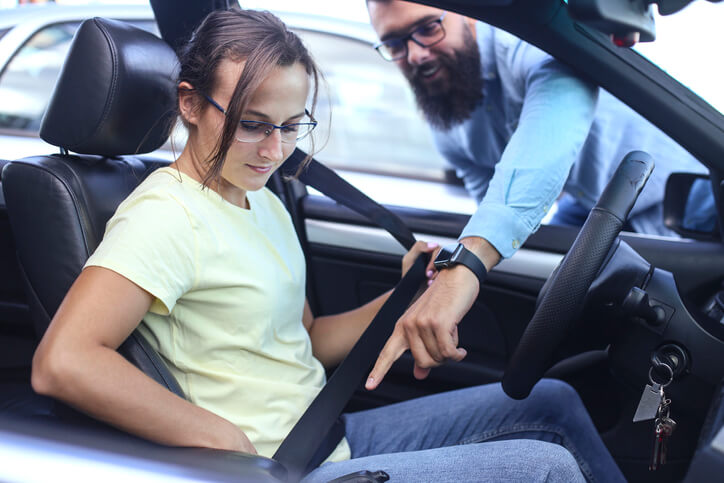Navigating the roads in Illinois can be both an exciting and challenging experience. Drivers of any experience level must stay informed and prepared with ever-changing driving laws and diverse weather conditions. Let's explore the latest updates to Illinois' driving laws, speed limits, and regulations and discuss essential car equipment, child safety, and road safety tips to ensure a smooth and safe journey on the state's highways and byways.
Illinois Driving Laws
- Illinois will implement new driving laws to provide carjacking victims with relief and encourage safe driving habits.
- Speed limits, toll roads, license requirements, essential car equipment, and safety measures must be adhered to or face possible fines/penalties.
- Electric vehicle charging stations are available in Illinois for travelers seeking convenient transportation.
New Illinois Driving Laws
One notable change to Illinois laws in 2023 is the relief provided to carjacking victims. Under this new legislation, victims can now be reimbursed for towing and storage fees, as well as impounding fees, up to $1,000, easing the financial burden they may face. This is a significant step towards supporting those who have experienced such a traumatic event.
School zone regulations have also been modified, with community service now being imposed as a penalty for failing to stop for a school bus displaying visual signals or for speeding more than 20 miles per hour in a school zone. These stricter penalties aim to ensure the safety of students and encourage drivers to be more vigilant in these areas.
Another noteworthy change is Illinois’ adoption of new laws, including the National Novice Teen Driver Education and Training Administrative Standards, which cover driver’s education requirements such as behind the wheel hours. This new law aims to foster safe driving habits among young drivers and decrease future motor vehicle accidents.
Speed Limits and Regulations
Speed limits in Illinois vary according to the type of road and vehicle. Specific counties also enforce unique speed limits on particular roads. For instance, automobiles on urban interstates have a speed limit of 55 miles per hour, while the maximum speed limit for cars on rural interstates is 70 miles per hour.
Penalties for speeding in Illinois can be severe, with fines ranging from $120 for driving between one and 20mph over the speed limit up to $2,500 and a possible prison sentence for exceeding the limit by 40mph. Drivers must be mindful of and comply with speed limits to avoid these penalties and help make the road safer for everyone.
Toll Roads and Payment Methods
Illinois is home to five major toll roads, offering drivers a convenient way to traverse the state. Drivers can manage toll payments using the I-PASS website or app, offering a straightforward and efficient process.
Toll fees vary depending on the road and type of vehicle. For example, the fee for a car on the Jane Addams Memorial Tollway ranges from $0.36 to $1.90, while a truck traveling on the Ronald Reagan Memorial Tollway during the day may incur fees ranging from $1.50 to $9.45.
License Requirements and Age Restrictions
Obtaining a driver’s license in Illinois involves different requirements for teens and adults. For teens, they must log at least 50 hours of supervised driving practice, including 10 hours at night, before applying for an initial driver’s license. Adults, on the other hand, do not need to obtain an instruction permit to apply for a Class D or Temporary Visitor full driver’s license if they are at least 18 years old.
To obtain a driver’s license, applicants must gather the appropriate documentation, pass a vision screening, and complete written and driving tests. When renewing a driver’s license, a written test may be required every 8 years if the licensee has any traffic convictions or accidents on their record.
In some cases, the road test can be bypassed when applying for an Illinois driver’s license. This exception is possible if the applicant has successfully completed a high school driver’s education course with a grade of A or B and passed the state-approved driving exam. In such cases, presenting a Cooperative Driver Testing Certificate at the Secretary of State Facility may allow the applicant to avoid the road test.
Essential Car Equipment and Safety Measures
Illinois law mandates that all vehicles be equipped with essential safety equipment, including:
- Two headlights
- Two tail lights
- Brake turn lights
- A rear license light
- Backup lights
Maintaining the functionality of these lights is imperative for the safety of both the driver and other road users.
In addition to equipment requirements, Illinois law also enforces various vehicle safety measures. These include:
- the use of seat belts
- maintaining a safe following distance
- adherence to passing rules
- prohibition of cellphone use while driving
These and other safety measures aren’t just the law, they’re put into place to help protect you and the others on the road, so knowing and implementing them is essential.
Penalties for Traffic Violations
Traffic violations in Illinois carry a range of penalties, including fines, community service, and license suspension. For instance, penalties for speeding include fines that vary depending on the violation’s speed and possible license suspension if the violation occurs in a school zone.
Drunk driving also carries severe consequences in Illinois, with fines, imprisonment, and license suspension or revocation depending on the severity of the offense. For example, a first-time offense is classified as a Class A misdemeanor, with fines of up to $2,500 and possible jail time of up to 364 days, while repeat offenses or aggravated DUIs carry increasingly severe penalties.
Another example of a traffic violation is running a red light, which can result in fines ranging from $100 to $1000.
Meanwhile, driving without a license in Illinois is classified as a Class B misdemeanor, which may incur a jail sentence of up to six months and a fine of up to $1,500. Drivers must comply with traffic laws to evade these penalties and ensure road safety.
Child Safety and Car Seat Requirements
When it comes to child safety, Illinois has specific car seat regulations to ensure the well-being of young passengers. Children under the age of 2 are required to be adequately secured in a rear-facing child restraint system unless they exceed 40 pounds in weight.
Also, it is suggested that children aged 4 to 8 are secured in a forward-facing car seat with an internal harness system. Those aged 8 to 12 should continue using booster seats until they can fit properly in the adult lap/shoulder belt due to their appropriate stature. Compliance with these regulations is enforced by the Illinois Child Passenger Safety Protection Act, and non-compliance may result in fines and penalties.
Fuel and Electric Vehicle Charging Stations
With the increasing prevalence of electric vehicles, Illinois provides several fuel and electric vehicle charging stations to cater to drivers’ needs. There are approximately 1,000 publicly accessible EV charging stations in Illinois, with companies like:
- ChargePoint
- EVgo
- Electrify America
- Greenlots
Providing charging services for a variety of devices, including hands-free kits, ensures that customers can stay connected and powered up throughout the day.
In addition to electric vehicle charging stations, traditional fuel stations are readily available throughout the state.
Interstate Travel and Car Rentals
If you’re planning a road trip or require a temporary vehicle, car rental services such as Hertz and SIXT provide a handy option for interstate travel within Illinois and to neighboring states. SIXT’s Illinois branch is located in Chicago, making it easily accessible for travelers in and around the city.
Popular road trip destinations in Illinois include Chicago and the shoreline of Lake Michigan, offering picturesque scenery and a variety of attractions for the whole family to enjoy.
Known Problem Intersections and Roadways
Illinois, particularly in the Chicago area, has several intersections and roadways known for high rates of traffic tickets and vehicle collisions. Here are some notable locations:
- Stony Island Avenue at South Chicago Avenue – Located on Chicago’s South Side, this intersection is particularly dangerous and borders four neighborhoods: Avalon Park, Greater Grand Crossing, South Shore, and South Chicago.
- Western Avenue at Peterson Avenue – Known for its high traffic and complex layout, this intersection had 50 crashes and is further complicated by a car dealership’s driveway.
- Kedzie Avenue and Belmont Avenue – The diagonal one-way roads and an underpass connected to the Kennedy Expressway make this intersection confusing and hazardous.
- Lincoln and Clark – A busy intersection frequented by both vehicles and bicyclists, with no bike lanes and diagonal roads, posing risks for accidents.
- Milwaukee Avenue (0.7 mile stretch between North and Division) – This area sees a high volume of cyclists, adding to the confusion and risk of accidents.
- Cicero Avenue and I-55 – Near Midway, this intersection is busy with airport traffic and has the most profitable red-light camera in Chicago, indicating a high rate of red-light running and related accidents.
- Irving Park, Cicero, and Milwaukee – Known as the “triple threat,” this intersection is dangerous for drivers, bikers, and pedestrians due to its six corners and multiple directions of traffic.
- North, Damen, and Milwaukee – Located in Wicker Park, this intersection is known for heavy traffic and numerous pedestrians and bikers.
- Stony Island, 79th, and South Chicago – As Illinois’ most dangerous intersection, this six-way intersection is complex, making left turns particularly risky.
- East 79th Street & South Stony Island Avenue – Recorded as the most dangerous intersection in Chicago wa Collision Risk Index (CRI) score of 293 means always exercise extra caution here.
The list of the 15 most dangerous intersections in Chicago also includes locations such as East 95th Street & South Stony Island Avenue, West Garfield Boulevard & South Wentworth Avenue, and North Michigan Avenue & East Wacker Drive, each with significant numbers of crashes and injuries.
These intersections are characterized by high traffic volumes, complex road designs, and high rates of vehicle collisions, making them hazardous for both drivers and pedestrians. It’s crucial to be extra cautious and aware when navigating these areas.
Weather Conditions and Road Safety Tips
Illinois experiences a wide range of weather conditions throughout the year, with winter temperatures averaging around 20°F. Drivers should plan their road trips according to the weather and maintain safe driving habits under varying weather conditions.
When driving in winter conditions, be aware of the possibility of icy roads, snow drifts, and decreased visibility. Before hitting the road, check the weather forecast and adjust your plans. Reduce your speed and increase the gap between your vehicle and the one ahead to ensure a safe driving experience in these challenging conditions.
Summary
In conclusion, staying informed about Illinois’ driving laws, speed limits, regulations, and safety measures is crucial for a safe and enjoyable driving experience. By familiarizing yourself with the latest updates, such as new driving laws and child safety regulations, and practicing safe driving habits in diverse weather conditions, you can help create a safer road environment for yourself and others. Remember, knowledge is power – and in this case, knowledge can also save lives.
Frequently Asked Questions
Can a 16-year-old driver have passengers in Illinois?
In Illinois, a 16-year-old driver is only allowed one passenger under 20 years of age, unless the passenger is a direct family member.
What is the new Illinois driving law?
Illinois’ new driving law prohibits the operation of a motor vehicle while using any electronic communication device, including video conferencing or social media. This law is in effect now, and drivers should be aware of it.
What is the U-turn law in Illinois?
In Illinois, U-turns are regulated by the Illinois Vehicle Code (625 ILCS 5/11-802). According to this law, U-turns can only be made when safe and without interfering with other traffic.
What is the new law for suspended licenses in Illinois?
As of January 1, 2023, the SAFE-T Act has been implemented in Illinois and no longer allows individuals to face license suspension for unpaid traffic tickets.
What are the requirements to drive in Illinois?
In order to drive in Illinois, those under the age of 18 must enroll in an approved state-approved driver education course and obtain a learner’s permit by passing vision and written tests. Additionally, nighttime driving restrictions of 10 pm – 6 am Sunday – Thursday and 11 pm – 6 am Friday – Saturday may apply.









